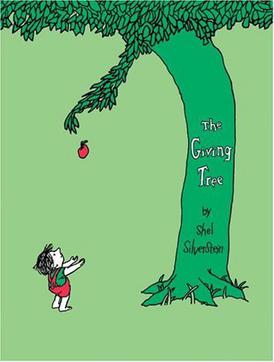The Giving Tree
The Giving Tree is a children's picture book written and illustrated by Shel Silverstein. First published in 1964 by Harper & Row, the book has become one of Silverstein's most famous works and has been translated into numerous languages. It is a story about the relationship between a young boy and a tree.
Plot[edit | edit source]
The narrative follows the life-long relationship between a boy and an apple tree. In his childhood, the boy enjoys playing with the tree, climbing its trunk, swinging from its branches, and eating its apples. However, as the boy grows older, his visits become less frequent, and his requests from the tree become more about material needs, such as money, a house, and a boat. The tree continues to give the boy everything it can, sacrificing its apples, branches, and trunk, until it is reduced to a stump. In the end, the boy, now an old man, returns to the tree, which says it has nothing left to give. The boy replies that all he needs is a quiet place to sit and rest, which the stump provides. The story concludes with the line, "And the tree was happy."
Themes[edit | edit source]
The book explores themes of unconditional love, selflessness, and sacrifice, as well as the nature of happiness and the passage of time. The tree's constant giving and the boy's increasing demands have led to various interpretations, including those that see the tree as a symbol of parental love, the environment, or Christ. Critics have discussed the book's portrayal of a one-sided relationship, with some viewing the tree's self-sacrifice as positive and others as problematic.
Reception[edit | edit source]
The Giving Tree has received mixed reviews since its publication. Some critics praise its emotional depth and the simplicity of its illustrations and text, while others criticize it for its depiction of a seemingly selfish boy and the tree's endless martyrdom. Despite this, the book has remained popular among both children and adults, often being used in moral and religious education.
Legacy[edit | edit source]
The book has left a significant legacy, influencing various fields including education, psychology, and environmentalism. It has been adapted into animations, theater productions, and music, reflecting its broad appeal and the universality of its themes. The Giving Tree is considered a classic of children's literature and continues to be a subject of study and analysis.
See Also[edit | edit source]
Search WikiMD
Ad.Tired of being Overweight? Try W8MD's physician weight loss program.
Semaglutide (Ozempic / Wegovy and Tirzepatide (Mounjaro / Zepbound) available.
Advertise on WikiMD
|
WikiMD's Wellness Encyclopedia |
| Let Food Be Thy Medicine Medicine Thy Food - Hippocrates |
Translate this page: - East Asian
中文,
日本,
한국어,
South Asian
हिन्दी,
தமிழ்,
తెలుగు,
Urdu,
ಕನ್ನಡ,
Southeast Asian
Indonesian,
Vietnamese,
Thai,
မြန်မာဘာသာ,
বাংলা
European
español,
Deutsch,
français,
Greek,
português do Brasil,
polski,
română,
русский,
Nederlands,
norsk,
svenska,
suomi,
Italian
Middle Eastern & African
عربى,
Turkish,
Persian,
Hebrew,
Afrikaans,
isiZulu,
Kiswahili,
Other
Bulgarian,
Hungarian,
Czech,
Swedish,
മലയാളം,
मराठी,
ਪੰਜਾਬੀ,
ગુજરાતી,
Portuguese,
Ukrainian
Medical Disclaimer: WikiMD is not a substitute for professional medical advice. The information on WikiMD is provided as an information resource only, may be incorrect, outdated or misleading, and is not to be used or relied on for any diagnostic or treatment purposes. Please consult your health care provider before making any healthcare decisions or for guidance about a specific medical condition. WikiMD expressly disclaims responsibility, and shall have no liability, for any damages, loss, injury, or liability whatsoever suffered as a result of your reliance on the information contained in this site. By visiting this site you agree to the foregoing terms and conditions, which may from time to time be changed or supplemented by WikiMD. If you do not agree to the foregoing terms and conditions, you should not enter or use this site. See full disclaimer.
Credits:Most images are courtesy of Wikimedia commons, and templates Wikipedia, licensed under CC BY SA or similar.
Contributors: Prab R. Tumpati, MD

